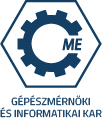| Course objectives: |
| The aim of the course is to learn the basis of cutting, the general and characteristic cutting procedures of component production, and machining procedures of typical surfaces. |
| Course content and structure: |
| Precision machining in extreme conditions (geometry, accuracy, surface quality, non-traditional materials, low chip cross-section area, high cutting speed). Machinability and cutting of special materials. The characteristics of the chip removal. Chip deformation, cutting forces, heat phenomenons. Applied cutting tool materials. Requirements of tool design. Wear and tool life of cutting tools. Regeneration of cutting tools. Accuracy and surface quality of machined surfaces. Cutting of up to date and hardly machinable materials (high strength, heat- and corrosion-resistant materials, cheramics, non-ferrous metal alloys, fiber reinforced materials). |
| Evaluation method: |
| Written and oral exam |
| Required reading: |
| 1. David Dornfeld, Dae-Eun Lee: Precision Manufacturing, Springer, 2008, p775 2. Mark J. Jackson: Micro and Nanomanufacturing, Springer, 2007, p699 3. König, W.: Fertigungsverfahren Band 1. Drehen, Fresen, Bohren. VDI - Verlag GmbH, Düsseldorf, 1981.4. Horváth, M. - Somló, I.: A forgácsoló megmunkálások optimálása és adaptív irányítása, Műszaki Kiadó, Budapest, 1979. 5. Pálmai, Z.: Fémek forgácsolhatósága, Műszaki Könyvkiadó, Budapest, 1980. |
| Suggested reading: |
| 1. Milton C. Shaw: Metal Cutting Principles, Clerandon Press-Oxford, 1997.2. Annals of the CIRP (1985-2000.).3. Novikov, N. V. - Bondarev E. K. - Ginzburg B. I. et. al.: Sinteticheskie sverkhtvjordye materialy, 1. 2. 3., Kiev, Naukova Dumka, 1986. 4. Bobrov, V. M.: Osnovy teorü reznija metallov, Mashinostroenie, Moskva, 1975. |


